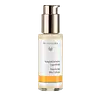What's inside
What's inside
 Key Ingredients
Key Ingredients

No key ingredients
 Benefits
Benefits

 Concerns
Concerns

 Ingredients Side-by-side
Ingredients Side-by-side

Water
Skin ConditioningPrunus Armeniaca Kernel Oil
MaskingSimmondsia Chinensis Seed Oil
EmollientCarthamus Tinctorius Seed Oil
MaskingCetearyl Alcohol
EmollientGlycerin
HumectantRosa Canina Seed Extract
EmollientButyrospermum Parkii Butter
Skin ConditioningCitrus Aurantium Dulcis Fruit Water
MaskingCetearyl Glucoside
EmulsifyingChamomilla Recutita Flower Extract
MaskingSodium Stearoyl Glutamate
CleansingRosmarinus Officinalis Leaf Extract
AntimicrobialTocopherol
AntioxidantPelargonium Graveolens Oil
MaskingSodium Levulinate
Skin ConditioningSodium Anisate
AntimicrobialLavandula Angustifolia Oil
MaskingBeta-Sitosterol
Emulsion StabilisingSodium Dehydroacetate
PreservativeSqualene
EmollientLactic Acid
BufferingWater, Prunus Armeniaca Kernel Oil, Simmondsia Chinensis Seed Oil, Carthamus Tinctorius Seed Oil, Cetearyl Alcohol, Glycerin, Rosa Canina Seed Extract, Butyrospermum Parkii Butter, Citrus Aurantium Dulcis Fruit Water, Cetearyl Glucoside, Chamomilla Recutita Flower Extract, Sodium Stearoyl Glutamate, Rosmarinus Officinalis Leaf Extract, Tocopherol, Pelargonium Graveolens Oil, Sodium Levulinate, Sodium Anisate, Lavandula Angustifolia Oil, Beta-Sitosterol, Sodium Dehydroacetate, Squalene, Lactic Acid
Water
Skin ConditioningAlcohol
AntimicrobialPersea Gratissima Oil
Skin ConditioningAnthyllis Vulneraria Extract
Skin ConditioningGlycerin
HumectantTapioca Starch
Prunus Armeniaca Kernel Oil
MaskingSesamum Indicum Seed Oil
EmollientSodium Silicate
BufferingEquisetum Arvense Extract
AstringentAcacia Senegal Gum
MaskingVeronica Officinalis Flower/Leaf/Stem Extract
AstringentTropaeolum Majus Flower/Leaf/Stem Extract
Skin ConditioningDaucus Carota Sativa Root Extract
Skin ConditioningSalvia Officinalis Leaf Extract
CleansingHippophae Rhamnoides Fruit Oil
Skin ProtectingSimmondsia Chinensis Seed Oil
EmollientGlyceryl Citrate/Lactate/Linoleate/Oleate
EmulsifyingParfum
MaskingCitral
PerfumingLimonene
PerfumingCitronellol
PerfumingLinalool
PerfumingGeraniol
PerfumingXanthan Gum
EmulsifyingAlgin
MaskingGlyceryl Oleate Citrate
EmulsifyingSucrose Polystearate
EmollientHelianthus Annuus Seed Oil
EmollientCitric Acid
BufferingPropolis Wax
EmollientWater, Alcohol, Persea Gratissima Oil, Anthyllis Vulneraria Extract, Glycerin, Tapioca Starch, Prunus Armeniaca Kernel Oil, Sesamum Indicum Seed Oil, Sodium Silicate, Equisetum Arvense Extract, Acacia Senegal Gum, Veronica Officinalis Flower/Leaf/Stem Extract, Tropaeolum Majus Flower/Leaf/Stem Extract, Daucus Carota Sativa Root Extract, Salvia Officinalis Leaf Extract, Hippophae Rhamnoides Fruit Oil, Simmondsia Chinensis Seed Oil, Glyceryl Citrate/Lactate/Linoleate/Oleate, Parfum, Citral, Limonene, Citronellol, Linalool, Geraniol, Xanthan Gum, Algin, Glyceryl Oleate Citrate, Sucrose Polystearate, Helianthus Annuus Seed Oil, Citric Acid, Propolis Wax
Ingredients Explained
These ingredients are found in both products.
Ingredients higher up in an ingredient list are typically present in a larger amount.
Glycerin is already naturally found in your skin. It helps moisturize and protect your skin.
A study from 2016 found glycerin to be more effective as a humectant than AHAs and hyaluronic acid.
As a humectant, it helps the skin stay hydrated by pulling moisture to your skin. The low molecular weight of glycerin allows it to pull moisture into the deeper layers of your skin.
Hydrated skin improves your skin barrier; Your skin barrier helps protect against irritants and bacteria.
Glycerin has also been found to have antimicrobial and antiviral properties. Due to these properties, glycerin is often used in wound and burn treatments.
In cosmetics, glycerin is usually derived from plants such as soybean or palm. However, it can also be sourced from animals, such as tallow or animal fat.
This ingredient is organic, colorless, odorless, and non-toxic.
Glycerin is the name for this ingredient in American English. British English uses Glycerol/Glycerine.
Learn more about GlycerinThis ingredient is the oil from the apricot.
Apricot Kernel Oil is an emollient and helps soften skin. This is due to its fatty acid components. Some of these fatty acids include linoleic and oleic acid.
This ingredient also has antioxidant properties from Vitamins A, C, and E. Antioxidants help fight free-radicals. Free-radicals are molecules that may damage your skin cells. Besides being antioxidants, these vitamins provide plenty of skin benefits as well.
Learn more about Prunus Armeniaca Kernel OilThis oil comes from the seeds of the desert shrub called Jojoba. It is more commonly known as jojoba oil, a non-comedogenic oil.
Jojoba oil does not contain fragrance and has many fatty-acids, making it a great soothing ingredient.
It also contains Vitamin E, a great moisturizing ingredient. Vitamin E is also an antioxidant and protects your skin against oxidative damage.
This ingredient humectant properties, meaning it helps draw moisture from the air. This helps keep your skin hydrated.
While jojoba has antibacterial properties, it is only able to kill some strains of bacteria.
Studies also show it helps in wound healing. In fact, Indigenous cultures have used jojoba as a moisturizer and to help treat burns for centuries.
Fun fact: Jojoba oil similar to natural human skin sebum, so it has a great effect on dry skin. It is also promising with helping to regulate sebum production.
Due to its fatty acid content, Jojoba oil may not be fungal acne safe. We recommend speaking with a professional if you have any concerns.
Learn more about Simmondsia Chinensis Seed OilWater. It's the most common cosmetic ingredient of all. You'll usually see it at the top of ingredient lists, meaning that it makes up the largest part of the product.
So why is it so popular? Water most often acts as a solvent - this means that it helps dissolve other ingredients into the formulation.
You'll also recognize water as that liquid we all need to stay alive. If you see this, drink a glass of water. Stay hydrated!
Learn more about Water